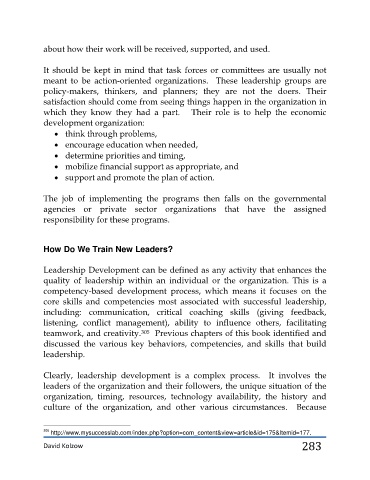Page 283 - 4- Leading_from_Within
P. 283
about how their work will be received, supported, and used.
It should be kept in mind that task forces or committees are usually not
meant to be action-oriented organizations. These leadership groups are
policy-makers, thinkers, and planners; they are not the doers. Their
satisfaction should come from seeing things happen in the organization in
which they know they had a part. Their role is to help the economic
development organization:
• think through problems,
• encourage education when needed,
• determine priorities and timing,
• mobilize financial support as appropriate, and
• support and promote the plan of action.
The job of implementing the programs then falls on the governmental
agencies or private sector organizations that have the assigned
responsibility for these programs.
How Do We Train New Leaders?
Leadership Development can be defined as any activity that enhances the
quality of leadership within an individual or the organization. This is a
competency-based development process, which means it focuses on the
core skills and competencies most associated with successful leadership,
including: communication, critical coaching skills (giving feedback,
listening, conflict management), ability to influence others, facilitating
teamwork, and creativity. 305 Previous chapters of this book identified and
discussed the various key behaviors, competencies, and skills that build
leadership.
Clearly, leadership development is a complex process. It involves the
leaders of the organization and their followers, the unique situation of the
organization, timing, resources, technology availability, the history and
culture of the organization, and other various circumstances. Because
305
http://www.mysuccesslab.com/index.php?option=com_content&view=article&id=175&Itemid=177.
David Kolzow 283

